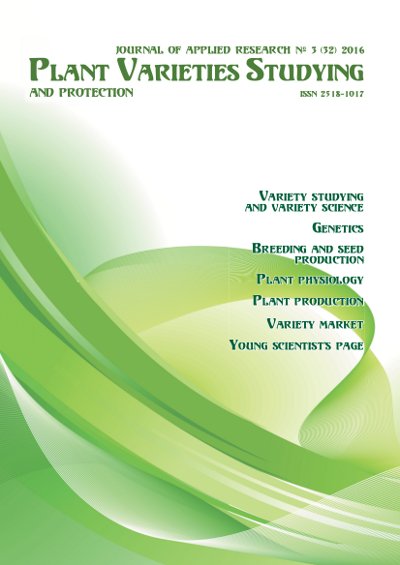Formation of spring rape yield depending on fractional composition of seed material
DOI:
https://doi.org/10.21498/2518-1017.3(32).2016.75988Keywords:
spring rape, fraction, quality, density, leaf surface area, photosynthetic productivityAbstract
Purpose. To study the influence of fractional composition of seed material on productive properties of spring rape seeds of the ‘Magnat’ variety and ‘MVM’ (‘Gladiator’) variety sample.
Methods. Field investigations, laboratory tests, statistical analysis.
Results. During 2013–2014, the influence of sown seeds of different size fractions (up to 2,5 g; 2,6–3,5 g; 3,6 g and more) on the indices of productivity of spring rape varieties was studied. It was found that over the years of study field germination of sown fractions of seeds in ‘Magnat’ variety averaged 83.5%, in ‘MSM’ variety sample – 86.7%. During the periods of seedling emergence and harvesting, the density of spring rape crops varied depending on relevant fraction of sown seeds. In the ‘Magnat’ variety, photosynthetic potential of crops ranged from 1.1 to 1.3 million m2/ha, in ‘MSM’ variety sample – from 1.2 to 1.6 million m2/ha. Depending on the seed fractions applied, ‘Magnat’ variety crops during the growing season accumulated organic biomass from 2.05 to 2.36 g/m2
per day, ‘MSM’ sample variety – from 1.83 to 2.10 g/m2 per day.
Conclusions. It was established that different fractions of spring rape seeds sown in the Northern Forest-Steppe zone of Ukraine affected the indices of germinating energy and laboratory germination, crop density formation, leaf surface area and intensity of photosynthesis process (crop photosynthetic potential, net photosynthesis performance). The highest indices of productivity and yield in the ‘Magnat’ variety was ensured by large-seeded fraction (3,6 g and more), in the ‘MVM’ (‘Gladiator’) sample variety – by small-seeded fraction (up to 2,5 g).
Downloads
References
Kozlenko, O. M. (2011). Produktyvnist yarykh oliinykh kultur zalezhno vid elementiv tekhnolohii vyroshchuvannia v Pravoberezhnomu Lisostepu Ukrainy [Performance of spring oilseed crops depending on growing technology elements in the Right-Bank Forest-Steppe zone of Ukraine] (Extended Abstract of Cand. Agric. Sci. Diss.). National University of Life and Environmental Sciences of Ukraine, Kyiv, Ukraine. [in Ukrainian]
Strona, I. G. (1966). Obshchee semenovedenie polevykh kul’tur [General seed studies of field crops]. Moscow: Kolos. [in Russian]
Moroz, V. M. (2006). Systema pervynnoho vysokoiakisnoho nasinnytstva ripaku [Primary system of high-quality rapeseed breeding]. Kyiv: EKMO. [in Ukrainian]
Firsova, M. K., & Popova, E. P. (1981). Otsenka kachestva zerna i semyan [Evaluation of the quality of grain and seeds]. Moscow: Kolos. [in Russian] 5. Haro, V. Ye., Danylova, O. I., & Karpiuk, Yu. M. (2009). Consumer properties of rapeseed. Naukovi pratsi Odeskoi natsionalnoi akademii kharchovykh tekhnolohii [Proceedings of Odessa National Academy of Food Technologies], 36(1), 22–26. [in Ukrainian]
Vyshnivskyi, P. S. Hubenko, L. V., Remez, H. H., & Lepekha, V. H. (2009). The impact of fertilizers and sowing methods on the productivity of spring rape. Zbirnyk naukovykh prats NNTs “Instytut zemlerobstva UAAN” [Proceedings of the NSC “Institute of Agriculture of UAAS”], 1–2, 99–104. [in Ukrainian]
Saiko, V. F., Kaminskyi, V. F., Vyshnivskyi, P. S., Hubenko, L. V., Korniichuk, M. S., Buslaieva, N. H., & Shliakhturov, D. S. (2011). Osoblyvosti provedennia doslidzhen z khrestotsvitymy oliinymy kulturamy [Features of studying cruciferous oilseeds]. P. S. Vyshnivskyi (ed.). Kyiv: N.p. [in Ukrainian]
Downloads
Published
How to Cite
Issue
Section
License
Copyright (c) 2016 Ukrainian Institute for Plant Variety Examination

This work is licensed under a Creative Commons Attribution-ShareAlike 4.0 International License.
Starting in 2022, the copyright to the publication remains with the authors
Our journal abides by the CREATIVE COMMONS copyright rights and permissions for open access journals.
Authors, who are published in this journal, agree to the following conditions:
- The authors reserve the right to authorship of the work and pass the first publication right of this work to the journal under the terms of a Creative Commons Attribution License, which allows others to freely distribute the published research with the obligatory reference to the authors of the original work and the first publication of the work in this journal.
- The authors have the right to conclude separate supplement agreements that relate to non-exclusive work distribution in the form in which it has been published by the journal (for example, to upload the work to the online storage of the journal or publish it as part of a monograph), provided that the reference to the first publication of the work in this journal is included.

























 Ukrainian Institute for Plant Varieties Examination
Ukrainian Institute for Plant Varieties Examination  Селекційно-генетичний інститут
Селекційно-генетичний інститут Institute of Plant Physiology and Genetics of the National Academy of Sciences of Ukraine
Institute of Plant Physiology and Genetics of the National Academy of Sciences of Ukraine
 The National Academy of Agrarian Sciences of Ukraine
The National Academy of Agrarian Sciences of Ukraine